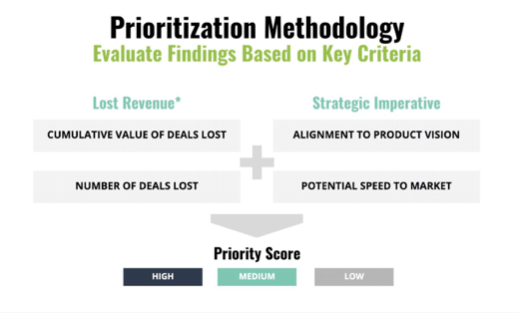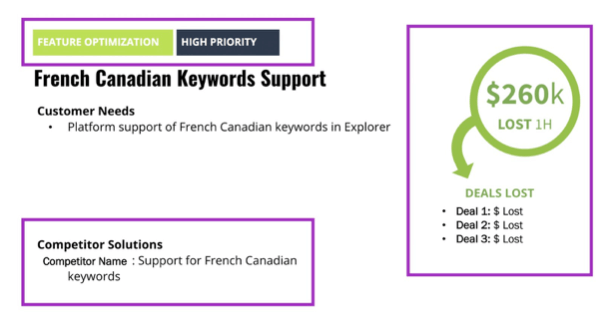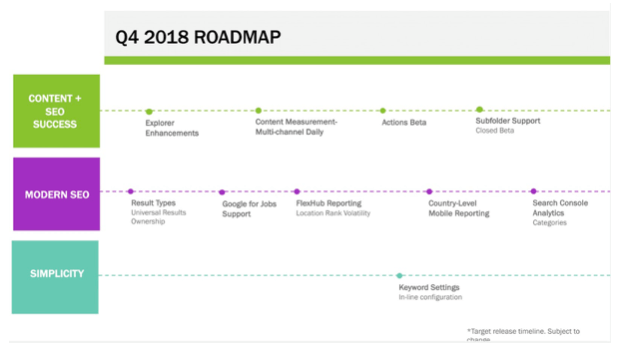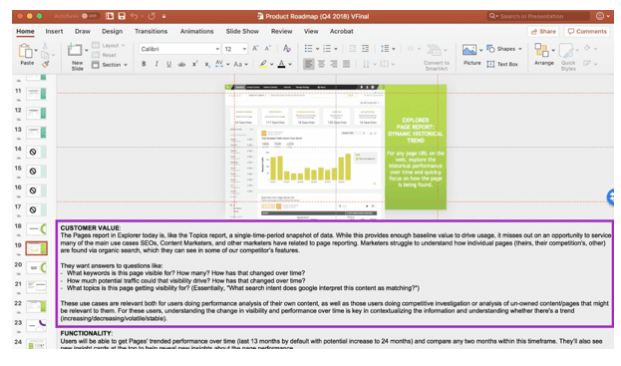Lindsay Boyajian is now the Vice President of Marketing at Conductor
The product roadmap is so important, it helps a business say what they’re going to deliver and why it matters. But product marketing too often is left out of the roadmap process.
My name's Lindsay Boyajian, I am on the product marketing team at Conductor.
For those of you who don't know Conductor, we are an SEO and content marketing software company. We help everyone from Citi to Argos to Lyft, make sure their content is actually found on Google when everyone's searching for them.
Often you hear of product managers going off away from the product marketers in the room, and creating the roadmap, and then coming back out and saying "Here, product marketers, here's the roadmap".
But that process is fundamentally broken because product marketers have so much to offer and so many insights to bring to that. So in this article, I'll be talking about what we can offer into the roadmap and how we can bring that to our customers and prospects.
I'll be focusing on topics such as:
What is a product roadmap?
A product roadmap is a strategic document that maps out what you're going to deliver over time in your product, maybe it's a quarter, maybe it's six months, but it's visual, and it helps the business say what are we going to deliver?
But a really good product roadmap says, why is this actually important? Why is what we're delivering over the next quarter, six months, going to impact you, Mr. Mrs. customer?
If you Google product roadmap, they show a bunch of different visuals, you can see here they come in all different shapes and sizes but it is a visual representation and can be an extremely valuable tool.
What I argue is we should all be sharing our product roadmaps with our customers and our prospects.
Why should you share your roadmap?
There's a tonne of value. Depending on the size of your business, obviously, and the type of business you run it could be difficult, but coming from B2B SaaS, there's tremendous value we found in making our product roadmap available to customers and prospects.
Improve customer relationships
First, when you think about your product roadmap and sharing it with customers, there's a tonne of value in opening the kimono up to your customers and say, "Hey, here's what we have coming up over the next six months, here's what we have over the next quarter" and engaging them in that feedback.
Demonstrate innovation
One, it shows them, wow, these guys are actually innovative. They're thinking differently, maybe than some of the folks in the market especially if they have an exciting roadmap.
Address pain points
Two, maybe it's not the most exciting roadmap, but it's addressing some of those fundamental core pain points in your product or product gaps that customers have been talking about and bringing up to your team over and over again.
Feedback
Secondly, it's that opportunity for feedback, "Hey, this is coming in six months, what do you think about this?" This is going to solve that problem. Awesome. Let me see if I can get you into early beta for that when it's time. You can begin to have that conversation and it really starts to build loyalty, it builds that relationship between your customers.
Not only are they a consumer of your product, but now they're actually involved in shaping the roadmap, seeing what's coming. That can go tremendously far in terms of retention. That's especially true if your competitors aren't sharing roadmaps, it can be even more powerful.
Close new deals
Where I've seen the roadmap actually come into play and have the most impact is actually new business.
Differentiator
So especially if you're in a competitive space, you have competitive deals, the roadmap can be that one differentiator.
If you have the same feature checklist, and you're just checking boxes, and that's what the sales cycle is for you guys, coming in with a really strong roadmap in that late stage of the deal can be that differentiator for you.
It can be the difference between the prospect going with your competitor or going with you.
Share your vision
It enables you to show a level of innovation that may not be in the product today but it's coming down the pipeline. It can help explain your vision, you can talk about your vision as much as you want but actually showing the roadmap and how it's starting to come to life in your product that's really powerful to get that vision lock in the sales cycle.
Like I said, in competitive deals, it's really powerful.
Keep the conversation going
Also, late-stage in the deal, it's another excuse to hop on the phone with the prospect. Especially if you have a long sales cycle, you can run out of things to talk about with them or run out of reasons to hop on the phone.
This is another excuse, "We just got a new roadmap that came out, I have to show it to you and your boss". That's a great way to keep the conversation going, you're adding value and getting them really excited about becoming a partner with you.
Transparency and alignment
There's value in sharing your roadmap externally with customers and prospects, but also internally as well. What the product roadmap can do is it one, it keeps your product team accountable.
Accountability
It is a document and an artifact that says, "This is what we've committed to delivering". The word commitment can be scary for a lot of folks in R&D so this is your opportunity as the product marketer in the organization to say, what are we delivering?
Let's draw some lines in the sand here. It provides accountability as well. It's a great tool for a retro so, at the end of the six-month period, we say:
- What did we actually deliver?
- What did we miss?
- We missed out on a lot of these key dates that we said we're going to deliver, what's going on?
- Is our planning process broken?
- Is something going on in R&D that's slowing us down?
- Is something going on with the go-to-market that we're not prepared for?
- Where are we missing here?
So it's a great artifact for helping create that transparency and accountability and really having a dialogue of what's going on.
Org-wide transparency
Also, it helps to provide transparency across the organization. It enables your sales team to actually know what's coming down the pipeline.
The last thing we want to do is blindside the sales team with something new in the product, they have no idea what it is, they can demo it. They come to you the product marketer kind of upset. I'm sure we've all had that in one moment or another.
This can help avoid that because this gives them that six-month window into what's coming into the product.
Provide training and tools early
It gives you an opportunity as a product marketer to train them up early on the feature, give them some value props early and start giving them the tools they need to start talking about it and understanding what you're doing.
Especially if you're expanding your product, maybe into a new category, maybe it's a new functionality your solutions engineering team hasn't even seen before, it's a great way to start to get folks comfortable with a new language, new value props if you're opening up to new personas.
It lets you do a lot of the groundwork early so when it comes time to go to market and release the product in GA, your sales team already knows what they're doing. You already have demo flows available for them.
The solutions engineers have been talking about it for six months, they're ready to go. It makes the process between development and go-to-market a lot smoother when you have that available for folks.
Product marketing's role in the roadmap
Often product goes off and creates a roadmap but there's so much value we can bring to this roadmap planning process.
A linchpin between departments
In product marketing we are that linchpin, we connect sales to product, I can't tell you how many times a day I have meetings with each of these different departments, which is so unique for a team to be touching so many different internal stakeholders in one day.
Visibility
Meaning you have a lot of visibility into the company that each of these individual teams doesn't have.
- Sales, you're helping to enable and empower them.
- Customer success, same thing.
- Marketing, you're working with the individual channel owners.
- Product, you're helping run the user groups, you're partnering with them on their beta launches, and things like that.
Provide insights from the get-go
So having you in the room during the get-go of the planning process ensures you have insights from the beginning.
Unique context
You are not only delivering insights for what's going on in the business, being the voice of the business in the room during the planning process but you have unique context on the market and your customers.
Different perspective
You can be that voice in the room that brings a different perspective, you're seeing things through a different lens than the product team and being the one in the room that can raise your hand and say, "Hey, that's not what we're hearing in the field, I think we need to do a little bit more research".
Being that push can be really valuable and help you bring a stronger roadmap to market.
That's much easier said than done. I know. It's hard to get yourself wedged in the room with these planning meetings with product.
State of the Field
But one way we like to do it and one of the tactics we found really helpful to get us into the room was we actually started creating a state of the field.
Product marketing sits down with all the different stakeholders from sales and CS and we say, what happened over the last quarter or two quarters, depending on if you do it bi-annually:
- What happened?
- What deals did we lose?
- Which were the big ones?
We pull all of our data from Salesforce and then we also partner with the sales and CS leaders to go through, deal by deal, and we talk about them. It's not a quick process, but it helps us understand what product gaps are causing us to lose deals or what competitive functionality is causing us to lose deals.
Prioritization methodology
And we build a model based on that. We say based on the number of deals lost, the quantity of or the number of dollars lost over the last half-year, plus alignment to our vision, potential speed to market, we put all the features and functionality we lost deals to over the last six months, weight them, and then based on that we get a priority score.

What we serve up to the product team is a deck with a tonne of slides based on each product gap that looks something like this. Here's an example.

Shape the narrative
At the top, you can see is this a feature optimization? Is this competitive catch-up or parity? Are we asking for a net new feature? And then we get our priority score that comes from the model we just looked at.
Then, obviously, at the bottom here we also provide some competitive information and context as well. It's helpful, being the competitive expert in the room always gives you that edge with the product team and gives you that credibility that sometimes you need to bolster yourself.
Having that competitive information on the slide and being the expert in where the gaps are in your feature set compared to your competitors does really help.
Also, you can give a snapshot:
- Here's how much we lost last quarter.
- Here are some of the big ones, we lost Nike, Adidas, Uber, and
- Here's why.
You can go through an entire deck of that, product marketing leads that meeting and then we also have a sales leader and a CS leader in the room with us to give any context about the deals that may come up along the way.
That's one way you can start to get yourself into the conversation.
Build credibility
After a few quarters and doing those all of a sudden you might get that credibility with those product managers. Start to get the credibility and then all of a sudden, they feel like you're an asset in the room rather than a distraction.
Additionally, no one wants to see a slide that looks like this.

It's a list of features that no one cares about. None of you know what these things are, they mean nothing to you. That's how your customers and prospects feel when they see a slide that looks like this. It means nothing to them.
By having product marketing in the room, you're able to create a narrative around the features and the functionality.
You're the one that's going to create the why, the story, and really make it resonate with your customer. You're the one that's going to put that marketing glow on it and bring the features to life.
What are the use cases?
Why are we doing this?
Why does this tie to our bigger vision?
Because again, your customers don't want to see this, they want to understand the why behind what you're doing.
Having product marketing in the room from the get-go with a product team, you can understand the nuance of the story, you can help shape that with them and say, "Hey, we're doubling down on personalization in the story, let's maybe prioritize this feature over that feature", and you can help them understand the story.
For product managers that might not be product marketing oriented, they might not think that way so it's good to push them into that mindset.
Sales enablement & training
What we found, as I mentioned, the product roadmap is a really powerful tool in customer retention, and also new business.
But to do that, if you decide to give your sales team or your customer success team a roadmap to show, they need to be trained, they can't just go into the wild west with a new deck. It would be a little scary without the proper training and enablement.
With that, that's where product marketing can come into play. A lot of us either own enablement, or we partner super closely with the enablement teams and L&D teams within our organization.
Not only are you creating a deck for them to go into the market with, but you're also giving them a lot of different contexts.
This is an old roadmap but what you can see is in the talk track.

Not only are we saying this is what this feature does, but it's also a toggle, it's a widget. Now we're saying what's the value, maybe we're putting some customer stories in there, you know why we actually created this feature? Because this customer requested it, it's going to solve this problem.
Because that context and that texture around the feature helps your sales team sound a lot more credible, it gives them those anecdotes, those memorable moments on their calls that they can drop into.
So they're not just rattling through an entire deck of features and functionality. You'll see that we as product marketing craft the value statements and then obviously below it tells you, yeah this toggles or the functionality and more of the what.
But that is why it is so important and giving your sales team that one or two quick one-liners they can just drop on a call is so important. That's where product marketing comes into play.
Customer communication
Lastly, as I mentioned, customer communication.
With your roadmap, you have two options. You can give it to your sales team, your CS team, go one by one, and show it to different customers and prospects if you like.
But obviously, that doesn't scale as well, if you have big sales organizations, you may not be able to certify everyone or get everyone trained on it. So another way to get this out to folks is, we found it really successful hosting a webinar around it.
Webinar
Product marketing runs it with some product folks, we talk about the features, we tell stories. It's a great way to get it in front of all of our customers at scale, and also give our team exposure to our broader customer base as well and position us as product experts within our customer base.
So when we go to our customers and ask them to be in a user group or to participate in this survey, they've already interacted with our team in one of these webinars or sessions.
Product marketing's role: recap
The roadmap is so powerful.
Again, it might not be for everyone to share a roadmap publicly. What we found is very powerful as a B2B SaaS company.
Do we make it available on our website for everyone? No. But we do have avenues, whether it be through the webinar for customers, or we give it to our sales team or CS team, to get folks visibility into it.
By having product marketing in the room, you're going to have more insights into what's going on in the company, the market, and your customers infused into that. You're going to be able to shape the narrative so you have a stronger narrative within your roadmap, you're telling a story, it's not just a set of features being listed.
It's super beneficial for your go-to-market too, having a consistent story through your roadmap, that will follow you through your whole go-to-market for the quarter to come.
Again, you're just beating the drum of the narrative you're telling over and over. That starts with the roadmap and it goes through anything externally facing.
Sales enablement training - your roadmap is only as good as your sales team can communicate it and your customer success team can communicate about it.
If you have some qualms or you're a little nervous about folks going in the field with this deck, you can either give it to managers, that's a great way to do it. Or you can also certify folks too, you can't have this unless you get certified and pass this test or do a pitch practice with your manager and he or she approves you.
Lastly, customer communication, it's a great way to get customers excited about what's coming down the pipeline, build the relationship with customers, get their feedback, and then also get folks into betas early.
Before these features are even out and ready into the market, you can have a waitlist for beta users which we've seen is really successful for getting folks excited.
Thank you.
How to improve your Go-to-Market knowledge
Delivered by Yoni Solomon, Chief Marketing Officer at Uptime.com, Go-to-Market Certified includes everything you need to design, launch, and measure an impactful go-to-market strategy.
By the end of the course, you'll be able to confidently:
🚀 Grasp a proven product launch formula that’s equal parts comprehensive, repeatable, creative, and collaborative.
🧠 Gain the expertise and know-how to build and tailor an ideal product blueprint of your own.
🛠 Equip yourself with templates to facilitate a seamless GTM process.




